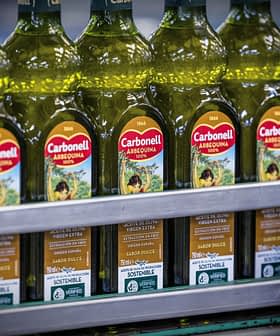Olive Oil Production Up More Than 25 Percent, Consumption Edges Higher
In its monthly newsletter, the International Olive Council released its preliminary data for the 2017/18 harvest season, which indicates increases in production, consumption and imports.
Provisional data analyzed by the International Olive Council (IOC) forecasts a 28 percent increase of olive oil production this year compared with last.
Global production reached 3,315,000 tons in the 2017/2018 crop year, although the data is only provisional.
The data, which was provided by both member and non-member countries, indicate the global production will reach 3,315,000 tons for the 2017/18 crop year, an increase of 723,500 tons compared with last year.
Tunisia experienced the largest increase, producing 280,000 tons, which was a 180 percent increase compared with last year. Italy also had a strong season, producing 428,900 tons, an increase of 135 percent.
Portugal, Argentina and Greece also experienced large increases, producing an additional 94 percent, 81 percent and 77 percent, compared with last year, respectively.
Meanwhile, Turkey and Morocco enjoyed more moderate increases, producing 48 percent and 27 percent more olive oil than last year, respectively. Overall, the European Union (EU) increased olive oil production by 25 percent compared with last year.
The notable exceptions to the production increases were in Algeria and Spain, which experienced decreases of an estimated 31 percent and 2.7 percent, respectively, compared with last year. However, Spain remains the world’s single largest producer with an output of 1,256,200 tons, making up about 38 percent of the world total.
According to the IOC, olive oil consumption also increased by 9 percent in the 2017/18 harvest season, reaching 2,958,000 tons.
Along with consumption, imports also increased in seven of eight of the IOC’s benchmark markets. These markets are generally characterized as countries that consume more olive oil than they produce, with the exception of the E.U.
© Olive Oil Times | Data source: International Olive Council
Imports to Brazil in the 2017/18 crop season grew the most at 29 percent, followed by Canada at 12 percent, the United States at four percent, Russia at two percent and both Australia and Japan at one percent.
China was the only country not to experience growth, with imports decreasing by eight percent compared with the previous year. However, the Chinese government had not released data since April 2018, so this figure could change.
In the EU, imports from non-member countries increased by 91 percent this harvest season. Exports from Tunisia were the largest contributor to this increase. Meanwhile, intra-EU imports decreased by six percent compared with last year.
Global extra virgin olive oil prices in the four largest producing countries remained “fairly stable” throughout the year but experienced some decreases in September.
Based on both official country data and estimates from the IOC Executive Secretariat, world olive oil production in 2018/19 is expected to fall by 7.6 percent to 3,064,000 tons. Olive oil consumption is expected to remain at a similar level.
Even so, the EU is expected to increase production by 1.1 percent, with most of the growth driven by Spain. Italy, Greece and Portugal are all expected to experience decreases. Outside of the EU, Algeria, Argentina, Egypt, Tunisia and Turkey are all expected to experience decreases as well.
However, these figures are based on preliminary estimates. The IOC Council of Members will conduct a more extensive survey in November to update these figures.








